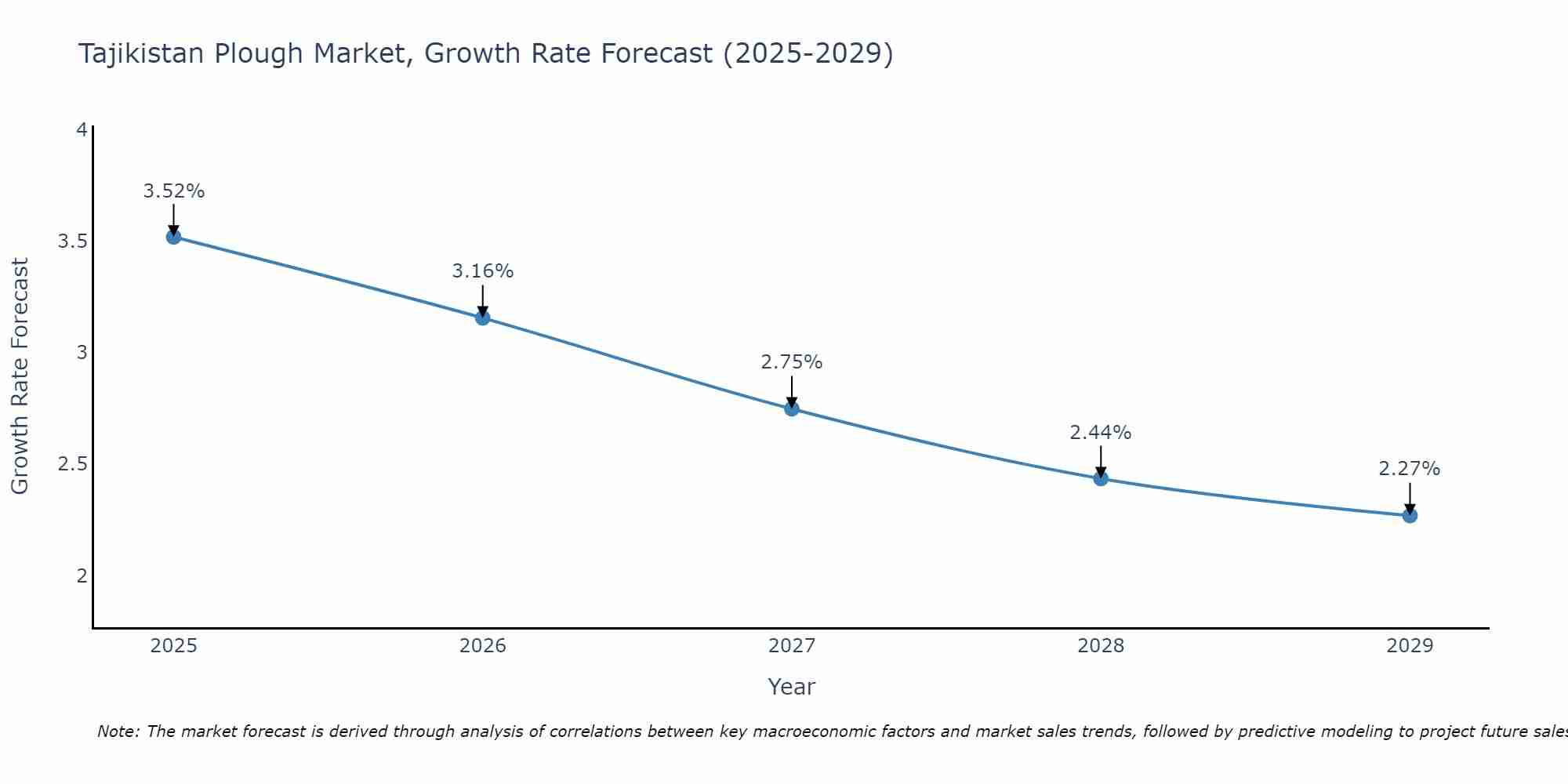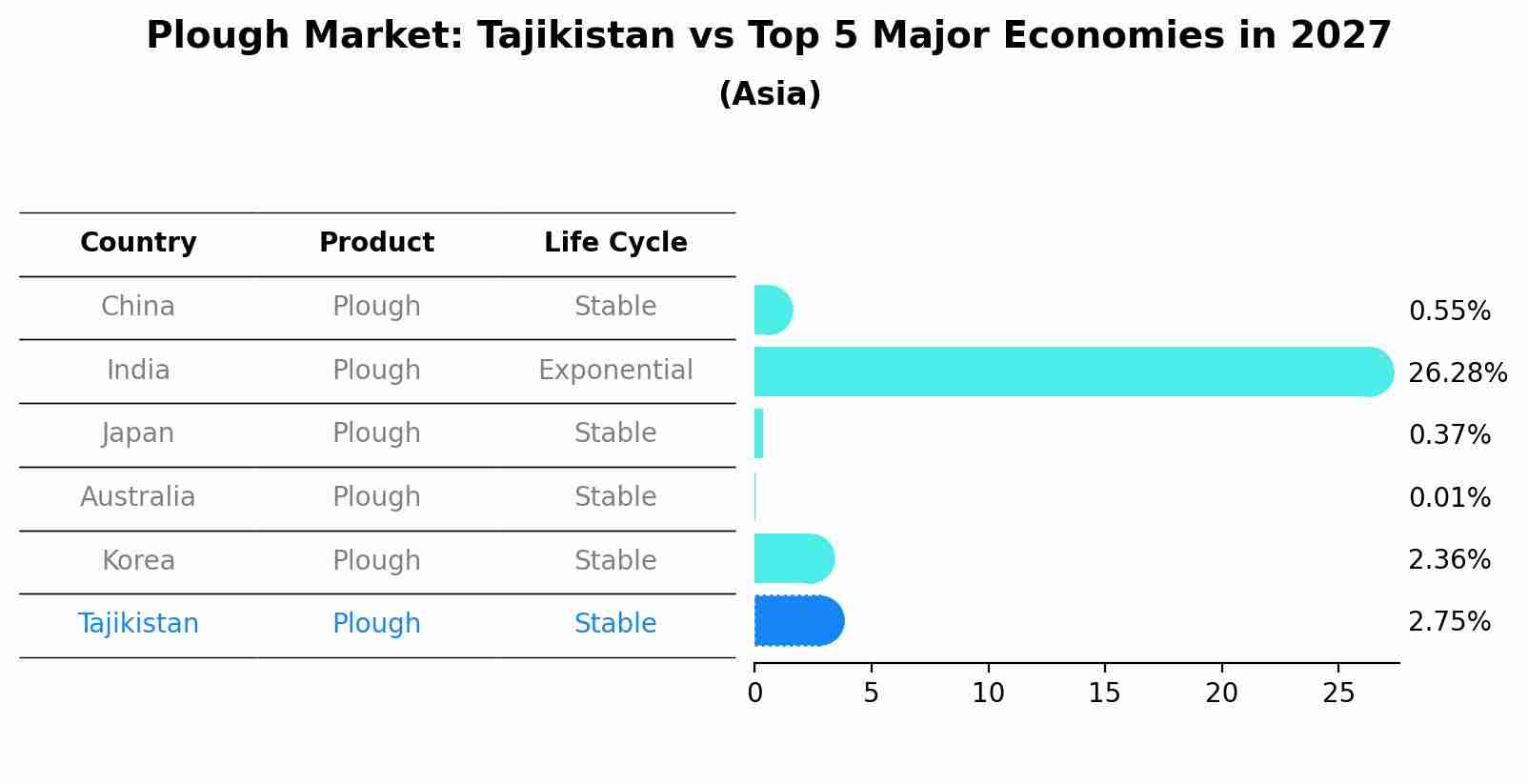Tajikistan Plough Market (2025-2031) | Share, Companies, Trends, Industry, Revenue, Size, Outlook, Value, Analysis, Growth & Forecast
| Product Code: ETC051519 | Publication Date: Jan 2021 | Updated Date: Jun 2025 | Product Type: Report | |
| Publisher: 6Wresearch | Author: Summon Dutta | No. of Pages: 70 | No. of Figures: 35 | No. of Tables: 5 |
Tajikistan Plough Market Size Growth Rate
The Tajikistan Plough Market may undergo a gradual slowdown in growth rates between 2025 and 2029. Although the growth rate starts strong at 3.52% in 2025, it steadily loses momentum, ending at 2.27% by 2029.

Plough Market: Tajikistan vs Top 5 Major Economies in 2027 (Asia)
The Plough market in Tajikistan is projected to grow at a stable growth rate of 2.75% by 2027, within the Asia region led by China, along with other countries like India, Japan, Australia and South Korea, collectively shaping a dynamic and evolving market environment driven by innovation and increasing adoption of emerging technologies.

Tajikistan Plough Market Overview
The Tajikistan plough market is characterized by a moderate growth rate driven by the agricultural sector`s reliance on traditional farming practices. The market primarily consists of small-scale local producers catering to the needs of individual farmers and small agricultural enterprises. The demand for ploughs in Tajikistan is influenced by factors such as land availability, government support for agriculture, and technological advancements in farming equipment. While manual ploughs are still commonly used in remote rural areas, there is a slow but steady shift towards mechanized ploughing methods. Key players in the market include local manufacturers and international brands seeking to expand their presence in the region. Overall, the Tajikistan plough market presents opportunities for growth through product innovation, improved distribution channels, and strategic partnerships with agricultural stakeholders.
Tajikistan Plough Market Trends
In Tajikistan, the plough market is experiencing a shift towards mechanization and modernization. Farmers are increasingly opting for tractor-mounted ploughs and other mechanized equipment to improve efficiency and productivity in their agricultural operations. There is a growing demand for ploughs that are compatible with tractors, as well as for specialized ploughs designed for specific soil types and farming practices. Additionally, there is a focus on sustainability and environmental impact, leading to the adoption of conservation tillage practices and reduced tillage ploughs. Overall, the Tajikistan plough market is witnessing a transition towards advanced technologies and practices to meet the evolving needs of the agricultural sector in the country.
Tajikistan Plough Market Challenges
In the Tajikistan plough market, several challenges are faced by both buyers and sellers. Limited access to financing hinders farmers` ability to invest in high-quality ploughs, leading to reliance on outdated and inefficient equipment. Lack of proper infrastructure and transportation facilities further complicates the distribution of ploughs to rural areas, resulting in delayed deliveries and increased costs for both buyers and sellers. Additionally, the presence of counterfeit or low-quality ploughs in the market poses a threat to consumer trust and satisfaction. Regulatory barriers and bureaucratic red tape also contribute to the challenges faced by market participants, impacting the overall efficiency and competitiveness of the plough market in Tajikistan. Addressing these challenges would require a coordinated effort from government agencies, financial institutions, and industry stakeholders to improve market conditions and support sustainable growth.
Tajikistan Plough Market Investment Opportunities
In Tajikistan, the plough market presents various investment opportunities for both local entrepreneurs and foreign investors. With agriculture being a key sector in the country`s economy, there is a growing demand for modern and efficient ploughing equipment to enhance productivity and yield. Investors can explore opportunities in manufacturing and supplying high-quality ploughs, providing training and technical support for farmers in ploughing techniques, or even investing in mechanized farming services. Additionally, there is potential for innovation in developing environmentally friendly and sustainable ploughing solutions to cater to the increasing global focus on sustainability. By tapping into the Tajikistan plough market, investors can contribute to the modernization and growth of the agricultural sector while also generating profitable returns.
Tajikistan Plough Market Government Policy
The Tajikistan government has implemented various policies related to the Plough Market in order to regulate and support the agricultural sector. These policies include providing subsidies and financial support to farmers to encourage the use of modern ploughing techniques, promoting sustainable farming practices, and ensuring fair pricing mechanisms for ploughs and related equipment. Additionally, the government has focused on improving infrastructure and access to markets for farmers to enhance the efficiency of the plough market. Overall, these policies aim to boost agricultural productivity, support rural livelihoods, and contribute to the overall economic development of Tajikistan.
Tajikistan Plough Market Future Outlook
The future outlook for the Tajikistan plough market appears to be positive, driven by the country`s continued focus on agricultural development and modernization. With a significant portion of the population engaged in agriculture, there is a consistent demand for ploughs and related agricultural equipment. Additionally, ongoing government initiatives to support farmers and improve agricultural productivity are expected to further boost the market. As farmers seek to increase efficiency and output, there will likely be a growing interest in advanced ploughing technologies and equipment. Overall, the Tajikistan plough market is projected to experience steady growth in the coming years, offering opportunities for both domestic manufacturers and international suppliers to cater to the evolving needs of the agricultural sector.
Key Highlights of the Report:
- Tajikistan Plough Market Outlook
- Market Size of Tajikistan Plough Market, 2024
- Forecast of Tajikistan Plough Market, 2031
- Historical Data and Forecast of Tajikistan Plough Revenues & Volume for the Period 2021 - 2031
- Tajikistan Plough Market Trend Evolution
- Tajikistan Plough Market Drivers and Challenges
- Tajikistan Plough Price Trends
- Tajikistan Plough Porter's Five Forces
- Tajikistan Plough Industry Life Cycle
- Historical Data and Forecast of Tajikistan Plough Market Revenues & Volume By Types for the Period 2021 - 2031
- Historical Data and Forecast of Tajikistan Plough Market Revenues & Volume By Traditional Plough for the Period 2021 - 2031
- Historical Data and Forecast of Tajikistan Plough Market Revenues & Volume By Modern Plough for the Period 2021 - 2031
- Historical Data and Forecast of Tajikistan Plough Market Revenues & Volume By Specialist Plough for the Period 2021 - 2031
- Historical Data and Forecast of Tajikistan Plough Market Revenues & Volume By Application for the Period 2021 - 2031
- Historical Data and Forecast of Tajikistan Plough Market Revenues & Volume By Farm for the Period 2021 - 2031
- Historical Data and Forecast of Tajikistan Plough Market Revenues & Volume By Individual Farming for the Period 2021 - 2031
- Tajikistan Plough Import Export Trade Statistics
- Market Opportunity Assessment By Types
- Market Opportunity Assessment By Application
- Tajikistan Plough Top Companies Market Share
- Tajikistan Plough Competitive Benchmarking By Technical and Operational Parameters
- Tajikistan Plough Company Profiles
- Tajikistan Plough Key Strategic Recommendations
Frequently Asked Questions About the Market Study (FAQs):
1 Executive Summary |
2 Introduction |
2.1 Key Highlights of the Report |
2.2 Report Description |
2.3 Market Scope & Segmentation |
2.4 Research Methodology |
2.5 Assumptions |
3 Tajikistan Plough Market Overview |
3.1 Tajikistan Country Macro Economic Indicators |
3.2 Tajikistan Plough Market Revenues & Volume, 2024 & 2031F |
3.3 Tajikistan Plough Market - Industry Life Cycle |
3.4 Tajikistan Plough Market - Porter's Five Forces |
3.5 Tajikistan Plough Market Revenues & Volume Share, By Types, 2024 & 2031F |
3.6 Tajikistan Plough Market Revenues & Volume Share, By Application, 2024 & 2031F |
4 Tajikistan Plough Market Dynamics |
4.1 Impact Analysis |
4.2 Market Drivers |
4.3 Market Restraints |
5 Tajikistan Plough Market Trends |
6 Tajikistan Plough Market, By Types |
6.1 Tajikistan Plough Market, By Types |
6.1.1 Overview and Analysis |
6.1.2 Tajikistan Plough Market Revenues & Volume, By Types, 2016 - 2031F |
6.1.3 Tajikistan Plough Market Revenues & Volume, By Traditional Plough, 2016 - 2031F |
6.1.4 Tajikistan Plough Market Revenues & Volume, By Modern Plough, 2016 - 2031F |
6.1.5 Tajikistan Plough Market Revenues & Volume, By Specialist Plough, 2016 - 2031F |
6.2 Tajikistan Plough Market, By Application |
6.2.1 Overview and Analysis |
6.2.2 Tajikistan Plough Market Revenues & Volume, By Farm, 2016 - 2031F |
6.2.3 Tajikistan Plough Market Revenues & Volume, By Individual Farming, 2016 - 2031F |
7 Tajikistan Plough Market Import-Export Trade Statistics |
7.1 Tajikistan Plough Market Export to Major Countries |
7.2 Tajikistan Plough Market Imports from Major Countries |
8 Tajikistan Plough Market Key Performance Indicators |
9 Tajikistan Plough Market - Opportunity Assessment |
9.1 Tajikistan Plough Market Opportunity Assessment, By Types, 2024 & 2031F |
9.2 Tajikistan Plough Market Opportunity Assessment, By Application, 2024 & 2031F |
10 Tajikistan Plough Market - Competitive Landscape |
10.1 Tajikistan Plough Market Revenue Share, By Companies, 2024 |
10.2 Tajikistan Plough Market Competitive Benchmarking, By Operating and Technical Parameters |
11 Company Profiles |
12 Recommendations |
13 Disclaimer |
- Single User License$ 1,995
- Department License$ 2,400
- Site License$ 3,120
- Global License$ 3,795
Search
Thought Leadership and Analyst Meet
Our Clients
Related Reports
- Germany Breakfast Food Market (2026-2032) | Industry, Share, Growth, Size, Companies, Value, Analysis, Revenue, Trends, Forecast & Outlook
- Australia Briquette Market (2025-2031) | Growth, Size, Revenue, Forecast, Analysis, Trends, Value, Share, Industry & Companies
- Vietnam System Integrator Market (2025-2031) | Size, Companies, Analysis, Industry, Value, Forecast, Growth, Trends, Revenue & Share
- ASEAN and Thailand Brain Health Supplements Market (2025-2031) | Strategy, Consumer Insights, Analysis, Investment Trends, Opportunities, Growth, Size, Share, Industry, Revenue, Segments, Value, Segmentation, Supply, Forecast, Restraints, Outlook, Competition, Drivers, Trends, Demand, Pricing Analysis, Competitive, Strategic Insights, Companies, Challenges
- ASEAN Bearings Market (2025-2031) | Strategy, Consumer Insights, Analysis, Investment Trends, Opportunities, Growth, Size, Share, Industry, Revenue, Segments, Value, Segmentation, Supply, Forecast, Restraints, Outlook, Competition, Drivers, Trends, Demand, Pricing Analysis, Competitive, Strategic Insights, Companies, Challenges
- Europe Flooring Market (2025-2031) | Outlook, Share, Industry, Trends, Forecast, Companies, Revenue, Size, Analysis, Growth & Value
- Saudi Arabia Manlift Market (2025-2031) | Outlook, Size, Growth, Trends, Companies, Industry, Revenue, Value, Share, Forecast & Analysis
- Uganda Excavator, Crane, and Wheel Loaders Market (2025-2031) | Strategy, Consumer Insights, Analysis, Investment Trends, Opportunities, Growth, Size, Share, Industry, Revenue, Segments, Value, Segmentation, Supply, Forecast, Restraints, Outlook, Competition, Drivers, Trends, Demand, Pricing Analysis, Competitive, Strategic Insights, Companies, Challenges
- Rwanda Excavator, Crane, and Wheel Loaders Market (2025-2031) | Strategy, Consumer Insights, Analysis, Investment Trends, Opportunities, Growth, Size, Share, Industry, Revenue, Segments, Value, Segmentation, Supply, Forecast, Restraints, Outlook, Competition, Drivers, Trends, Demand, Pricing Analysis, Competitive, Strategic Insights, Companies, Challenges
- Kenya Excavator, Crane, and Wheel Loaders Market (2025-2031) | Strategy, Consumer Insights, Analysis, Investment Trends, Opportunities, Growth, Size, Share, Industry, Revenue, Segments, Value, Segmentation, Supply, Forecast, Restraints, Outlook, Competition, Drivers, Trends, Demand, Pricing Analysis, Competitive, Strategic Insights, Companies, Challenges
Industry Events and Analyst Meet
Whitepaper
- Middle East & Africa Commercial Security Market Click here to view more.
- Middle East & Africa Fire Safety Systems & Equipment Market Click here to view more.
- GCC Drone Market Click here to view more.
- Middle East Lighting Fixture Market Click here to view more.
- GCC Physical & Perimeter Security Market Click here to view more.
6WResearch In News
- Doha a strategic location for EV manufacturing hub: IPA Qatar
- Demand for luxury TVs surging in the GCC, says Samsung
- Empowering Growth: The Thriving Journey of Bangladesh’s Cable Industry
- Demand for luxury TVs surging in the GCC, says Samsung
- Video call with a traditional healer? Once unthinkable, it’s now common in South Africa
- Intelligent Buildings To Smooth GCC’s Path To Net Zero


















